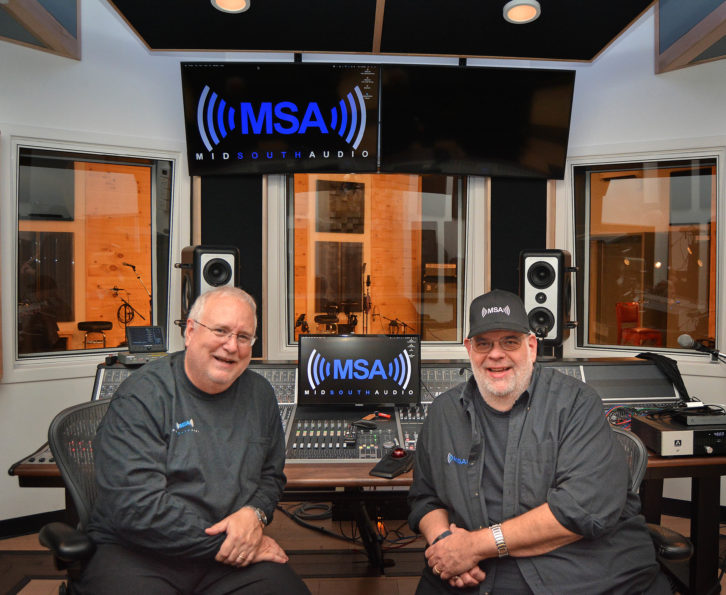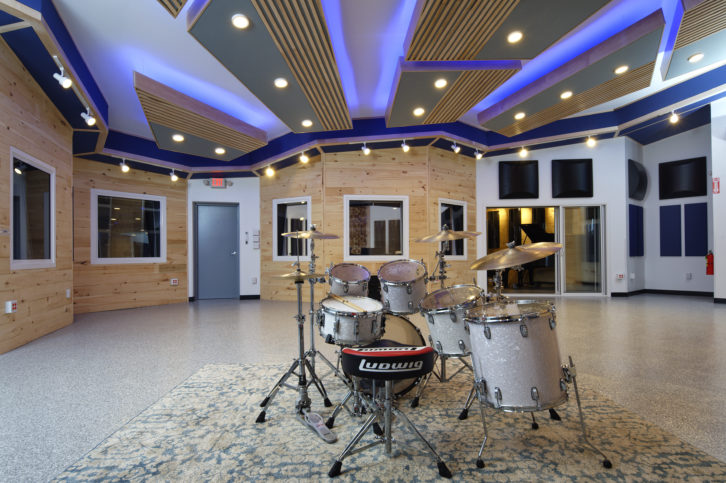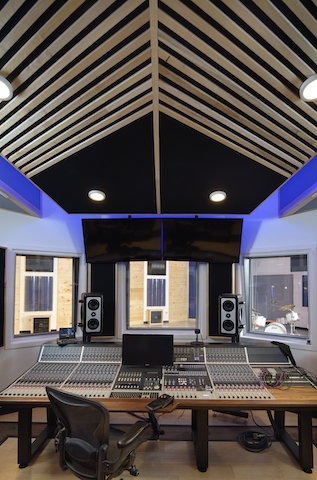
The recording studio has long proven a gateway into the entertainment and technology industries at large. How many kids in the late 1970s picked up a guitar, recorded a song, pieced together an 8-track analog studio in their hometown and went on to be a live sound mixer? How many students enter recording schools each year with visions of working at Abbey Road and wind up heading business development at a game company?
In the early 1980s, Delaware native and guitar player Kevin Short had a 16-track analog studio that he soon grew into an event production house, staging company and ultimately a leading mid-Atlantic audio-video-lighting integration company with reach across the country. On September 28, 2020, on the actual date of the company’s 31-year anniversary, Short opened a new 20,000-square-foot retail and showroom space for his company, Mid South Audio. True to his roots, he also built a brand new, world-class, Gavin Haverstick–designed recording studio.
And he did it during a very tough year, a year in which the event and production industry collapsed and while it has sometimes been tough to make ends meet, he has kept all of his employees employed, even shifting some of his production crew during the day to help with construction and wiring and building acoustic clouds.
“This is how it all started 30 years ago,” Short says, speaking from the new control room in early December. “The first thing in this whole history was a studio with 16 tracks. The rest is new for us—we’ve never done retail or a real showroom. We have done integration, of course, but we are doing so much more, and we wanted to kind of be revitalized. So we built this new place. And we built this studio and brought in Frank “The Punisher” Marchand to make it work. He is so respected in the area, and he has contacts with bands up and down the coast, and around the country.”
“Kevin was definitely thinking ahead when he decided on the studio, to have a place that sounds good, that’s big enough to handle eight or nine players at the same time,” says Marchand, who has had a many and varied audio life, most recently on the road mixing Calexico. “We blew the doors off with our first session. I had nine players on the floor, all in Nashville style, and we were tracking live. To be able to do that and then add the video content, it’s really turned out to be a blessing in disguise.”
Haverstick Designs
Today the 3500-square-foot recording complex sits at one end of the 20,000-square foot warehouse space and consists of the large live room with a piano booth and additional iso, a 20- x 15-foot control room and a second, smaller mix-production studio that also has access to the live room. The original plans were only slightly less ambitious when studio designer Gavin Haverstick of Haverstick Designs, Carmel, Ind., was brought on board in mid-2019.
The relationship between Short and Haverstick goes back nearly 10 years when they met at a conference, and Haverstick had done some minimal work on the previous Mid South Audio studio, as well as collaborating on a number of house of worship and event-space integration projects over the ensuing years. Haverstick, pleased to see a 20-foot structural ceiling height, suggested removing a few of the rectangular spaces and opening up the live room just a bit more.
“It was an empty shell, which is nice,” Haverstick recalls. “The back wall of the live room is about 16 feet, sloping down to about 13 at the front of the control room. There’s a solid trap that goes around the perimeter between the wall and the ceiling, and that is stuffed with insulation and it has a pegboard facing. So we’re not over-absorbing the high end and getting a little better performance in the low end. And then we also have some corner traps on that. There are also barrel diffusers up top—they’re great at trapping low frequency energy and still scattering the highs, keeping some liveliness there. And then down below, those are the Flex 48s, which is a product that I designed [and patented] for an absorber that you also want to be diffuser. Depending on the application, you can make the room live or slightly or more dead just by taking the Flex in and out. They have those in the live room and in the piano room and also the control room.”

The Flex 48, built by Acoustical Fulfillment and first installed in Jake Peavy’s Dauphin Street Sound Studios in Mobile, Ala., is a key component in Haverstick’s desire to provide clients with what he calls adaptive acoustics. “The Flex 48 was born from me constantly going into rooms where people were saying, ‘Yeah, in this iso room I’m going to record drums, vocals, acoustic guitar, mandolin’—15 different things. And I’m like, ‘Well, the room should sound different for each of those, no?’ And so it was really a tool that I developed. I mean, it’s not that adaptive treatment or variable acoustics is something groundbreaking. But there wasn’t really something that was off the shelf available from a manufacturer.”
Analog-Digital Control Room
Another prominent acoustic feature is the series of custom clouds hanging throughout, fabricated by the in-house team at Mid South Audio throughout the spring, after the partial shutdown.
“The primary function of the clouds is really kind of a three-fold bass trap because there’s so much insulation in the stressed absorption,”Haverstick explains. “And then that helps to bring some reflection back down to the performance as well as the performer. They’re about nine inches thick. There’s a prominent cloud in the control room. The front half of it is absorptive to catch the reflection points off the speakers. Then in the back are, there’s still insulation there, but you get a little bit of difffusion off of that, which helps in the rear. The room also increases the low-end absorption as you move back.
“The room actually slopes up to the back wall, sort of the reverse of the way it slopes down in the live room,” Haverstick continues. “So there’s a deep bass trap that’s right above that diffuser array on the back wall; I think at this point it’s probably four feet deep or so of the insulation. Then we have the Flex 48s in there as a way to get diffusion on the wall, which is always helpful in these spaces. But the information in the low end of the 48 is really high, toward a 0.9 absorption coefficient, which most small rooms struggle with that, that 125 Hertz range. It’s a way to get diffusion in the room while also offering bass trapping—without deadening it.”

The console choice was an Audient ASP824, chosen for its analog path and its ease in controlling DAWs. For monitors, Barefoot MicroMain27s, chosen for their mid-field performance, as they made an early decision to avoid soffit-mounted speakers and rely on the compact power of the Barefoots. A second, adjacent studio handles mixing, voice-over and production demands, based around a Pro Tools system and controller.
Opening night in September was a huge and rousing success, with all safety protocols in place, a live band on stage, the retail showroom wide open and a live tracking session throughout the evening featuring A-list talent, many of them flown in for the evening.
“It’s got a really large feel,” founder and owner Short says. “I mean, the room just feels good to record in and track live. On opening day, we had eight positions out on the floor all doing their thing and playing live, recording all at once. The record came out sounding really, really good.”
Yes, it’s been a tough year, and Short and team certainly didn’t need to go to such lengths. The integration and installation side of his business had been booming, even during the first ten months of the pandemic. And, let’s face it, recording studios aren’t on the list of Top 10 Moneymakers in 2020.
Still, Short is a smart man. And he has passion for sound and music. He knows that, while adjacent to the major metropolitan centers of the East Coast, his is more a destination facility, two minutes from the ocean and in a quiet, rural area, with all the conveniences of home. It’s ideal, he says, for a band looking for an isolated, private recording experience, or for local talent looking to access world-class space with high-end gear and talent.







